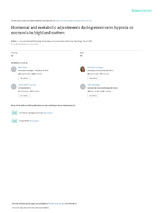Hormonal and metabolic adjustments during exercise in hypoxia or normoxia in highland natives

View/
Date
1996Author
Favier, R
Desplanches, D
Hoppeler, H
Cáceres, E
Grunenfelder, A
Koubi, H
Leuenberger, M
Sempore, B
Tüscher, L
Spielvogel, H
Metadata
Show full item recordAbstract
Abstract
In sea-level natives, exposure to hypoxia for a few weeks is characterized by an increased dependence on blood glucose and a decreased reliance on lactate for energy metabolism during exercise. These metabolic adjustments have been attributed to behavioral changes in the sympathoadrenergic and pancreatic systems. The aim of this study was to test the hypothesis of a reduced sympathoadrenergic activation and subsequent metabolic changes when high-altitude natives are acutely exposed to normoxia. Young Andean natives performed incremental exercise to exhaustion during hypoxia (arterial PO2 55.1 +/- 1.1 Torr) or during acute normoxia (arterial PO2 78.7 +/- 1.7 Torr). As a whole, oxygen uptake was increased in normoxia compared with hypoxia during graded exercise. This finding is not related to a decrease in anaerobic metabolism but rather is interpreted as a consequence of a shift in substrate utilization during exercise (increased contribution of fat as assessed by a reduction in the respiratory exchange ratio). These metabolic changes are not accompanied by modifications of glucoregulatory hormones (catecholamines, insulin, and glucagon). In particular, the exercise-induced catecholamine secretion was similar in chronic hypoxia and acute normoxia. As a consequence, blood lactate accumulation during incremental exercise was similar in both conditions. It is concluded that high-altitude natives do not display any sign of a greater sympathoadrenergic activation during chronic hypoxia and that the exercise-induced hormonal changes remained unaffected by acute inhalation of a normoxic gas mixture.
